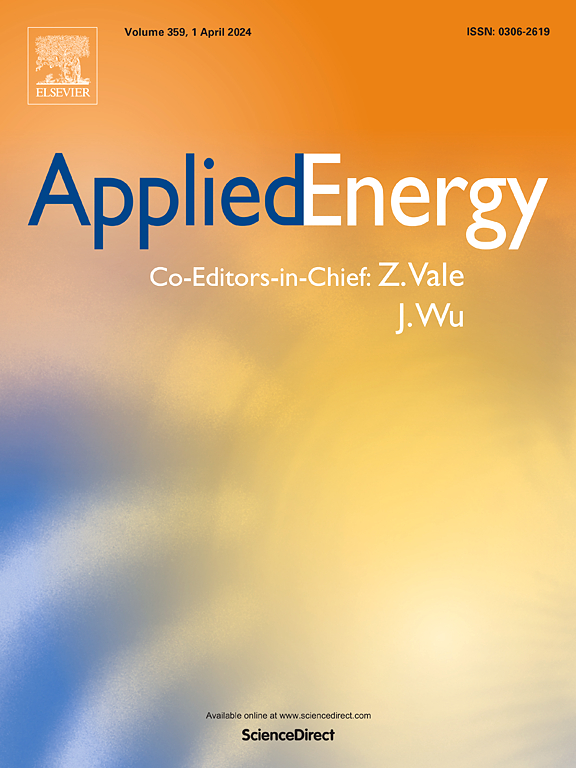Parallax and cloud shadow correction in satellite-based solar irradiance estimation: A study in tropical environments
IF 10.1
1区 工程技术
Q1 ENERGY & FUELS
引用次数: 0
Abstract
Accurate estimation of Global horizontal solar irradiance (GHI) from geostationary satellite imagery is essential for intraday solar PV power forecasting. Tropical regions show an even more challenging situation: A typically much higher tropopause results in higher cloud tops and correspondingly larger parallax errors in satellite imagery with significantly larger cloud shadow displacements compared to mid-latitudes. This study improves GHI estimates from Meteosat-8 by correcting cloud parallax and shadow displacement using gridded cloud top height (CTH) data. Fractional or sub-pixel displacement of individual cloudy pixels is enabled by bilinear interpolation in contrast to prior methods that allowed only integer shifts or assigned a single CTH value to a grouping of adjacent cloud pixels. Validation against one year of 15-min resolution ground-based measurements at five sites in South and Southeast Asia shows a reduction in relative root mean square error (rel. RMSE) from 23.8 % to 22.1 %. Improvements are more pronounced at higher satellite viewing zenith angles () and in the presence of high-altitude clouds. The corrected satellite-based GHI exhibits 4–7 percentage points lower rel. RMSE than National Solar Radiation Database (NSRDB) and 2.5 points lower than CAMS solar radiation service for similar . Greatest error reductions occur during partly cloudy conditions for sites within 61° , and under overcast skies for sites close to the edge of Meteosat-8's field of view. Improvements also depend on the co-scattering angle between sun and satellite with respect to the site, and the availability of sufficient upstream cloud information along the path of solar irradiance falling on the site. Ramp detection accuracy improves, particularly at lower detection thresholds, as measured using the Swinging Door Algorithm.
卫星太阳辐照度估算中的视差和云影校正:热带环境下的研究
从地球静止卫星图像中准确估计全球水平太阳辐照度(GHI)对于日间太阳能光伏发电预测至关重要。热带地区的情况更具挑战性:与中纬度地区相比,典型的高得多的对流层顶导致更高的云顶,相应的,卫星图像中的视差误差也更大,云影位移也更大。本研究通过使用网格化云顶高度(CTH)数据校正云视差和阴影位移,改进了Meteosat-8的GHI估计。与之前的方法相比,双线性插值可以实现单个云像素的分数或亚像素位移,而之前的方法只允许整数位移或为相邻云像素组分配单个CTH值。在南亚和东南亚的五个站点进行的为期一年的15分钟分辨率地面测量验证表明,相对均方根误差(rel. RMSE)从23.8%降低到22.1%。在较高的卫星观测天顶角(θsza)和有高空云的情况下,改进更为明显。修正后的基于卫星的GHI的rel. RMSE比国家太阳辐射数据库(NSRDB)低4-7个百分点,比CAMS太阳辐射服务低2.5个百分点。在61°θsza范围内的部分多云条件下,以及在靠近Meteosat-8视野边缘的多云天空下,误差减小最大。改进还取决于太阳和卫星相对于该地点的共散射角,以及沿落在该地点的太阳辐照度路径获得足够的上游云信息。斜坡检测精度提高,特别是在较低的检测阈值下,使用摆动门算法测量。
本文章由计算机程序翻译,如有差异,请以英文原文为准。
求助全文
约1分钟内获得全文
求助全文
来源期刊

Applied Energy
工程技术-工程:化工
CiteScore
21.20
自引率
10.70%
发文量
1830
审稿时长
41 days
期刊介绍:
Applied Energy serves as a platform for sharing innovations, research, development, and demonstrations in energy conversion, conservation, and sustainable energy systems. The journal covers topics such as optimal energy resource use, environmental pollutant mitigation, and energy process analysis. It welcomes original papers, review articles, technical notes, and letters to the editor. Authors are encouraged to submit manuscripts that bridge the gap between research, development, and implementation. The journal addresses a wide spectrum of topics, including fossil and renewable energy technologies, energy economics, and environmental impacts. Applied Energy also explores modeling and forecasting, conservation strategies, and the social and economic implications of energy policies, including climate change mitigation. It is complemented by the open-access journal Advances in Applied Energy.
 求助内容:
求助内容: 应助结果提醒方式:
应助结果提醒方式:


